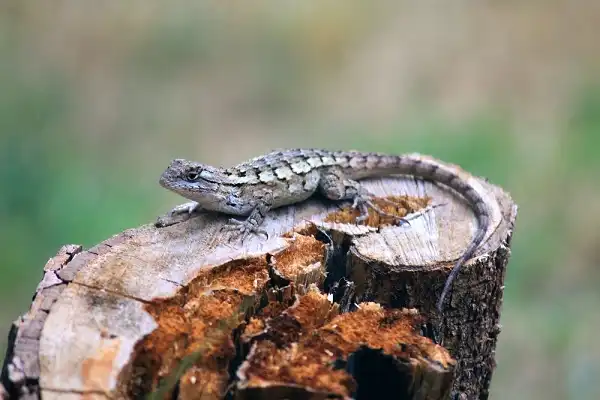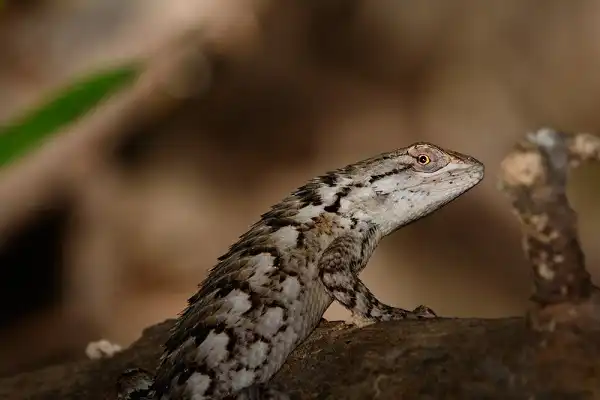Are you curious about the amazing reptiles of Texas? If so, then you’ll find the Texas spiny lizard absolutely fascinating! Native to South and West Texas, this reptile is known for its vibrant colors and distinctive spikes that cover its body. With up to nine different subspecies across Texas alone, they’re becoming an increasingly popular pet lizard for enthusiasts around the world. Let’s take a closer look at what makes these lizards so unique – from their remarkable behavior to how they survive in such a diverse environment – explore everything there is to know about the beloved Texas spiny lizard!

Texas Spiny Lizard Description
The Texas spiny lizard (Sceloporus olivaceus) is an impressive sight. Its body is covered in coarse, pebbly scales and noticeably sharp spines, which serve as a deterrent to predators. The lizard’s coloration is equally captivating, with shades of gray or brown, often speckled with black, white, or blue markings. These colors also aid in camouflage when they’re in their natural habitat. The spiny lizard’s most noticeable feature, its spines, are actually modified scales, which vary in size and shape between different subspecies. The spines along the side of their bodies and on their tails are larger and more prominent. These lizards have well-adapted legs and claws, designed for scaling trees and escaping predators. In particular, their hind limbs are longer and stronger, allowing them to leap between branches or dart away at high speeds when threatened. Their eyes are large and round with movable eyelids, providing a wide field of view and excellent visual acuity, crucial for hunting and evading predators. Their diet mainly comprises insects, spiders, and other small creatures.
Texas Spiny Lizard Habitat
The Texas spiny lizard thrives in a variety of habitats ranging from deciduous and pine-oak woodlands to more urban environments. They are arboreal lizards, meaning they spend most of their time in trees. Their preferred habitats are heavily wooded areas with plenty of climbing surfaces, such as tree trunks and branches. They are especially fond of mesquite trees, oak trees, and fences. In urban settings, these lizards can also be found in gardens, parks, and yards, where they use trees, fences, and other structures for basking and escaping predators. Even in these developed environments, they seek out places with dense vegetation that provide both shelter and hunting grounds. The adaptive nature of the Texas spiny lizard allows it to survive in a variety of climates, from the drier, hotter conditions of West Texas to the more humid environments of the South. However, they typically avoid extreme conditions and will seek shelter in crevices or under tree bark during periods of intense heat or cold.
Texas Spiny Lizard Diet
The diet of the Texas spiny lizard primarily consists of arthropods, making them insectivorous. They feast on a variety of insects such as beetles, grasshoppers, and caterpillars, along with spiders and other small invertebrates. The lizards use their sharp eyesight and quick reflexes to catch these prey, often lying in wait and ambushing them. They are also known to eat plant matter on occasion, including leaves and flowers, particularly during periods of food scarcity. This adaptability in their diet helps them survive in various environments, whether in the wild or in urban settings. In captivity, they can be fed a diet of crickets, mealworms, and other commercially available insects. It’s crucial to provide a balanced diet to these lizards, ensuring they receive the right nutrients for growth and health. For pet owners, dusting the insects with a calcium supplement before feeding is recommended to support the lizard’s bone health.

Texas Spiny Lizard Size
The size of the Texas Spiny Lizard is another fascinating aspect of this unique reptile. Adult males and females typically measure between 7.5 and 11 inches in total length, including their tail, making them medium-sized lizard species. This size range makes them noticeable yet manageable, which contributes to their popularity as pets among reptile enthusiasts. The males are generally slightly larger than females, a characteristic common in many lizard species. In addition to size, the males also boast more striking coloration, particularly during the breeding season when they display vibrant colors to attract mates. While their size and coloration are noteworthy, it’s also important to remember that these lizards are not just about appearance. Their size plays a crucial role in their survival strategies. For instance, their medium size allows them to effectively hide from predators and swiftly navigate their arboreal habitats. Moreover, their size also determines their dietary habits.
Texas Spiny Lizard Lifespan
The Texas Spiny Lizard is known to have a reasonably long lifespan, both in the wild and in captivity, adding to its appeal as a pet for reptile enthusiasts. In the wild, this species tends to live for an average of 5 to 7 years. This lifespan can be attributed to its robust survival strategies, including its effective adaptation to various environments, its diet, and its ability to evade predators with its agile movements and camouflage. In captivity, with the right care, these lizards can live significantly longer, with their lifespan extending up to 10 years, and in some cases, even beyond. The key to their longevity in captivity is proper care, including a balanced diet, an environment that simulates their natural habitat, and regular veterinary check-ups to ensure their health and well-being. It’s crucial for pet owners to understand the specific needs of this species to provide a suitable home that promotes their longevity.
Texas Spiny Lizard Behavior
The behavior of Texas Spiny Lizards is characterized by their diurnal and arboreal lifestyle. They are active during the day, often seen basking in the sun on tree trunks, fences, or rocks. Their strong legs and specialized toes enable them to expertly navigate their primarily tree-based habitats, climbing with agility and precision. As a defense mechanism, they are known to flee swiftly when threatened, often running on their hind legs to gain speed. One fascinating aspect of their behavior is their ability to blend into their surroundings. Their coloration varies based on their habitat, serving as camouflage against predators. During mating season, males perform push-up displays and color changes to attract females. These lizards are solitary outside the breeding season, marking and defending their territory from other males. They communicate using a combination of body postures, color changes, and movements.

Texas Spiny Lizard Speed
Texas Spiny Lizards are renowned for their agility and speed, attributes that play a crucial role in their survival both in the wild and in urban environments. While there is no specific recorded data on the exact speed of these lizards, they are observed to be quite quick when evading predators or hunting prey. Their strong, muscular legs and specialized toes allow them to sprint swiftly across the ground and climb trees with agility and precision. In terms of their ground speed, we can make an estimated comparison with other similar-sized lizards. For example, the common lizard (Zootoca vivipara) which is roughly the same size as the Texas Spiny Lizard, can reach speeds of up to 1.5 kilometers per hour. However, it should be noted that the Texas Spiny Lizard’s arboreal lifestyle might influence its ground speed, as these lizards are more adapted for climbing and may exhibit slower speeds on flat terrain.
Texas Spiny Lizard Reproduction
The reproduction cycle of the Texas Spiny Lizard begins with courtship, during which male lizards engage in displays of push-ups and changes in coloration to attract females. Once a female is receptive, mating ensues. Post-mating, the female lizard lays a clutch of eggs, usually ranging from 10 to 30 in number. The eggs are typically hidden in a safe, secluded spot, often within leaf litter or under logs, stones, or debris. Unlike many reptile species, the Texas Spiny Lizard does not exhibit parental care. The young lizards are thus left to fend for themselves after hatching. The incubation period for the eggs varies, generally lasting for 45 to 60 days. Upon hatching, the young lizards are miniature replicas of the adults, equipped with the skills and adaptations necessary for survival. However, their smaller size makes them vulnerable to a diverse array of predators during their early life stages.
Texas Spiny Lizard Hunting
The hunting technique of the Texas Spiny Lizard is a fascinating blend of patience, precision, and rapid action. This lizard is primarily insectivorous, feeding on a diet that comprises various insects, spiders, and other small invertebrates. One of their common strategies is to lie perfectly still, blending into their surroundings with their exceptional camouflage capabilities. They patiently wait for unsuspecting prey to come within striking distance. Once the prey is within reach, the lizard moves with quick and precise actions, capturing the prey in its mouth. Their swift reflexes are a crucial aspect of their hunting, allowing them to effectively catch even the fastest of insects. This rapid capture often involves a sudden, darting movement, which is facilitated by their strong legs and remarkable speed. In addition to their ground hunting, their arboreal lifestyle also opens up avenues for canopy hunting. They are known to leap from branches to capture flying insects, demonstrating their agility and adventurous spirit.

Conclusion
The Texas Spiny Lizard is truly an intriguing creature, displaying a remarkable blend of speed, agility, and adaptability. From their extraordinary camouflage abilities to their swift hunting tactics, these lizards are a testament to the wonders of evolution and the diversity of the reptile kingdom. They are an integral part of their ecosystem, helping to maintain a balance by controlling insect populations. Their reproductive habits, steeped in vibrant displays and seasonal patterns, further add to their captivating nature. In both wild and urban environments, these lizards are a fascinating study in survival and adaptation. To conserve and protect these unique creatures, understanding their behavior, lifestyle, and needs is vital. As we continue to study the Texas Spiny Lizards, we learn not only about them but also about the intricacies and marvels of the natural world they inhabit.
Frequently Asked Question


